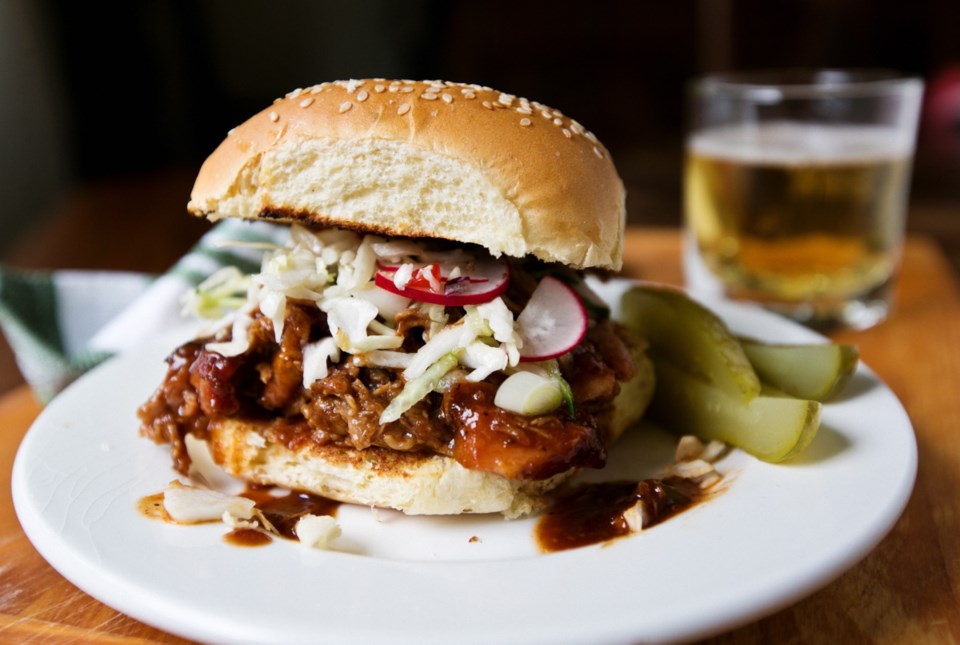 Dear Eric: In the past few years I have noticed the phrase “pulled pork.” I do not recall hearing it before. I am interested to know what pulled pork means. Dianne
Dear Eric: In the past few years I have noticed the phrase “pulled pork.” I do not recall hearing it before. I am interested to know what pulled pork means. Dianne
Dear Dianne: It’s not surprising that you’ve noticed the phrase “pulled pork.” These days numerous restaurants are featuring it on their menu and you know a dish has become way too trendy when fast food outlets, such as Burger King and KFC, are serving it.
This latter fact has aficionados of well-made pulled pork in a tizzy. They believe fast-food chains do not have the proper equipment, know-how and time to make pulled pork properly, and likely have what they sell shipped in, packed in a bag and ready to heat and serve.
That is not what south of border they would call “real” barbecue — an old and deeply ingrained technique in which hardwood smoke and indirect heat are used to slowly cook and infuse meat with flavour. Barbecue joints using that technique can be found from Texas to Tennessee to the Carolinas and many points beyond, and now numerous eateries here in Canada.
Southern barbecue joints cook in barbecue pits. It’s a brawny piece of equipment that has a large cooking chamber fitted with a separate chamber where cured pieces of wood, such as mesquite, hickory and apple, are placed. When the wood is lit, the smoke and heat is funnelled into the cooking chamber, smoking and cooking the food at low temperatures, without a flame ever touching it. Beef brisket, sausages, chicken, ribs and, of course, pulled pork are popular items to prepare this way.
To make pulled pork, a cut such as pork shoulder roast is seasoned and then slowly cooked and smoked at not much more than 200 F. During cooking, the meat is sometimes mopped or sprayed with a flavoured basting liquid, and near the end of cooking it might be glazed with a little barbecue sauce.
About 12 to 14 or more hours later, when the meat is very tender, it’s rested a while before being pulled into shreds, hence the name “pulled” pork.
The shredded meat is often moistened with some barbecue sauce and then piled into soft buns that are easy to bite through. Coleslaw might be piled onto the meat in the sandwich or served on the side.
Restaurants in Victoria preparing pulled pork this way include Pig Barbecue Joint (pigbbqjoint.com) and Smoken Bones Cookshack (smokenbones.ca).
At Pig, you can buy the sandwiches, or you can purchase a pound of pulled pork for $13. In the past I’ve brought it home and used it to make my own sandwiches or sliders. I would call that good value considering the long process required to prepare the meat.
I do also make my own pulled pork at home, and in a recent column offered a recipe for preparing it in a slow cooker. To find that recipe go timescolonist.com and search: Eric Akis slow cooker pulled pork.
Preparing it that way, of course, is not “real” barbecue. So if, like me, you don’t have a barbecue pit or smoker, you need an alternative.
I’ve provided a recipe for cooking the pork on a propane barbecue that uses indirect heat and wood chips to give the meat a smoky flavour. It’s not as good as you would get at your local tried and true barbecue joint, but it’s still deliciously succulent.
This recipe does require about eight hours of cooking, so make sure you have an adequate supply of gas before you start cooking, and make sure your schedule allows you to make periodic trips to the barbecue to do each step on time.
Pulled Pork Sandwiches
As noted above, this recipe requires about eight hours of cooking, so make sure you have an adequate supply of fuel before you start cooking.
Serve these smoky, hearty sandwiches with cold beer, pickles and coleslaw (see recipe below). You can serve the coleslaw alongside the sandwiches, or in the bun on top of the meat.
If this recipe yields too many servings for you, any leftover pulled pork will freeze well for you to later thaw, reheat and enjoy at another time.
Preparation time: 40 minutes
Cooking time: About 8 hours
Makes: 16 servings
2 cups woods chips (I used mesquite; see note)
1 Tbsp paprika
1 Tbsp chili powder
1 Tbsp ground cumin
2 tsp salt
• freshly ground black pepper to taste
2 (3 lb each) boneless pork shoulder roasts, warmed at room temperature 30 minutes
3 1/2 cups homemade or store-bought barbecue sauce, plus more to taste if needed
16 soft hamburger buns, split and warmed
Soak the wood chips in cold water for one hour and then drain well. Set three, 30-centimetre long sheets of aluminum foil on a work surface. Set about 2/3 cup of wood chips in the centre of each piece of foil. Fold the foil over the chips to create three sealed packets. Poke each packet a few times with a fork to allow smoke to escape.
Heat one side of your gas barbecue to medium-high. Place the paprika, chili powder, cumin, salt and pepper on a wide plate. Coat and rub each pork roast with this mixture.
Set one packet of wood chips under the grill, above the coals (burner) on the lit side of the barbecue. Set the roasts, fatty-side up, on the grill on the unlit side of the barbecue. Close the lid and adjust the heat so that the barbecue chamber is around 275 F to 300 F. During cooking, check the temperature and adjust as needed to maintain that temperature range.
Cook the pork for 90 minutes, and then set on another packet of wood chips. Cook 90 minutes more, and then set on the last packet of wood chips. Cook 2 hours more, and then lightly coat each roast with 1/3 cup of the barbecue sauce. Close the lid again and cook 30 minutes more.
When the 30 minutes is up, tear two 75-cm sheets of aluminum foil. Set a roast in the centre of each piece of foil. Lightly brush each roast with 1/3 cup more barbecue sauce, and then seal up each roast in the foil.
Set the pork back on the unlit side of the barbecue and cook 90 minutes to 2 1/2 hours more, or until the meat is at 185 F in the centre and tender enough to pull apart. Remove the pork from heat and rest in the foil 20 minutes.
Place the remaining barbecue sauce in a small pot, loosely cover and warm over medium-low heat. Unwrap the pork and set in a large bowl. Use two forks to pull the pork into shreds. Mix in 1 1/2 cups of the barbecue sauce, or to taste.
Divide and pile the pork on the bottom buns, top with more of the barbecue sauce and, if desired, coleslaw. Set on the top buns and serve.
Note: Wood chips for barbecuing are sold in bags at most stores that sell barbecues and related supplies.
Six-vegetable Coleslaw
This sweet-and-sour cole-slaw is made with a nutritious mix of vegetables. Serve this alongside or on top of the pulled pork sandwiches, above.
Preparation time: 20 minutes
Cooking time: none
Makes: 16 small servings (see Note)
1/3 cup cider vinegar
2 Tbsp honey
2 tsp Dijon mustard
• salt and freshly ground black pepper to taste
1Ú4 vegetable oil
4 cups finely shredded cabbage (about 1Ú2 small head)
1 cup coarsely grated carrot
1 cup coarsely grated yellow or green zucchini
6 radishes, halved and thinly sliced
3-4 green onions, thinly sliced
1 small red bell pepper, cut into small cubes
Mix vinegar, honey, mustard and salt and pepper in a large bowl. Slowly whisk in the oil. Toss in remaining ingredients and serve.
Note: the recipe should provide enough coleslaw to top each pulled-pork sandwich. If you would like to serve a more generous amount alongside, double the recipe.
Eric Akis is the author of the hardcover book Everyone Can Cook Everything. His columns appear in the Life section Wednesday and Sunday.
